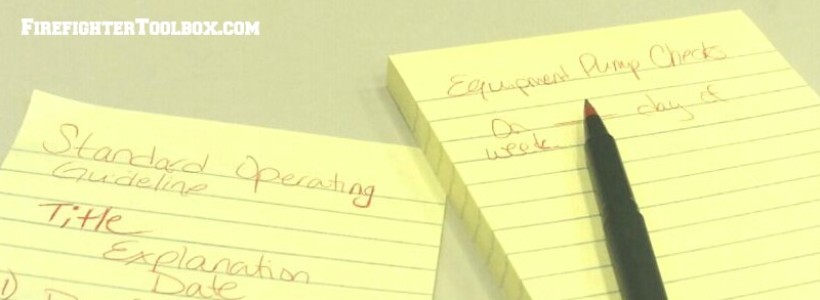4 Tips for Writing Department Standard Operating Guidelines
Writing department guidelines we will hold our members accountable to and expect them to follow is not an easy task and sometimes requires a little bit of trial and error to get it right. It’s a challenging, labor intensive, and mind numbing job that in today’s fire service is a must. Every department has a method for imparting the information; a lot of departments have gone to the FEMA adopted outline for SOG’s and then added their own content and modifications.
Here are 4 tips, that when writing guidelines will help make them easily understood and ensure that no content is missed in the processed.
Share Your Department’s Mission & Core Values:
The Standard Operating Guidelines are the book you are expecting every member of the department to read. After all you are going to be requiring them to follow these guidelines. In addition to conveying the mandatory information, we should be sharing with the company officers and line or floor firefighters what our department considers core values.
One paragraph less than a quarter of a page long that sets the tone is all that’s needed. Use something that is inspiring, descriptive, and direct. This is no easy task. It took me about 3 weeks to iron out 78 words recently for this very cause, but it was well worth it.
Be Brief and Direct:
Being too wordy often means some of the important information that we are trying to put in policy and guidelines gets overlooked because it’s placed in the middle of extra wording that just plain isn’t needed. So be brief. Take the following example: “The Station Captain at all times should ensure that good order and discipline is maintained for the good of the department.” The sentence for guideline purposes should be something more like: “The Station Captain is responsible for good order and discipline.” I used half the words to convey the same thing, and doing this throughout the document will cut down on a lot of paper and ensure that the important message is not lost.
Do NOT Try to Cover Every Circumstance:
When writing guidelines it’s important to remember that it is impossible to put down on paper every single type of call and every circumstance we may encounter on a call. A fire call is an ever-changing situation in which actions, inactions, weather, time, mechanical failure, and many others things can force a change in tactics and operations. Covering every type of situation is just not practical.
What we can do is use a basic check list system for the bigger types of calls and develop an easy to follow check list for company (Engine, Truck and Rescue) officers to follow. No more than one page, laminated that can be on the dash or in the command bag. Then have a master of all of these in the main SOG book.
Allow for On-Scene Discretion:
Often times when we are writing SOG’s in addition to trying to be all-inclusive, we often lock ourselves into a certain course of action based on our initial observations or worse yet lock ourselves into a certain course of action because that is what the SOG says must be done at that phase of the call.
When writing procedures or guidelines for the bigger types of calls, adding sentences like, “The Incident Commander may use his/her discretion based on the needs of the call” or “Based on the needs of the call the Incident Commander may use his/her discretion to” will give the Incident Commander flexibly to manage the call based on the situation they find themselves in.
There are some things that must be done in order for a call to go smoothly and safely. Listing these items without assigning a timeline outlines what must be done but allows the officer to roll with the flow of the call.
As an officer I know what needs to be done; I also know what the SOG’s of my department say I have to do, but allowing me to run the call based on the call in front of me without being restricted by timeline makes the flow of the call go much smoother.
Below is a link to the FEMA document published on creating Standard Operating Guidelines:
https://www.usfa.fema.gov/downloads/pdf/publications/fa-197-508.pdf
Photo Courtesy Erik Wood





